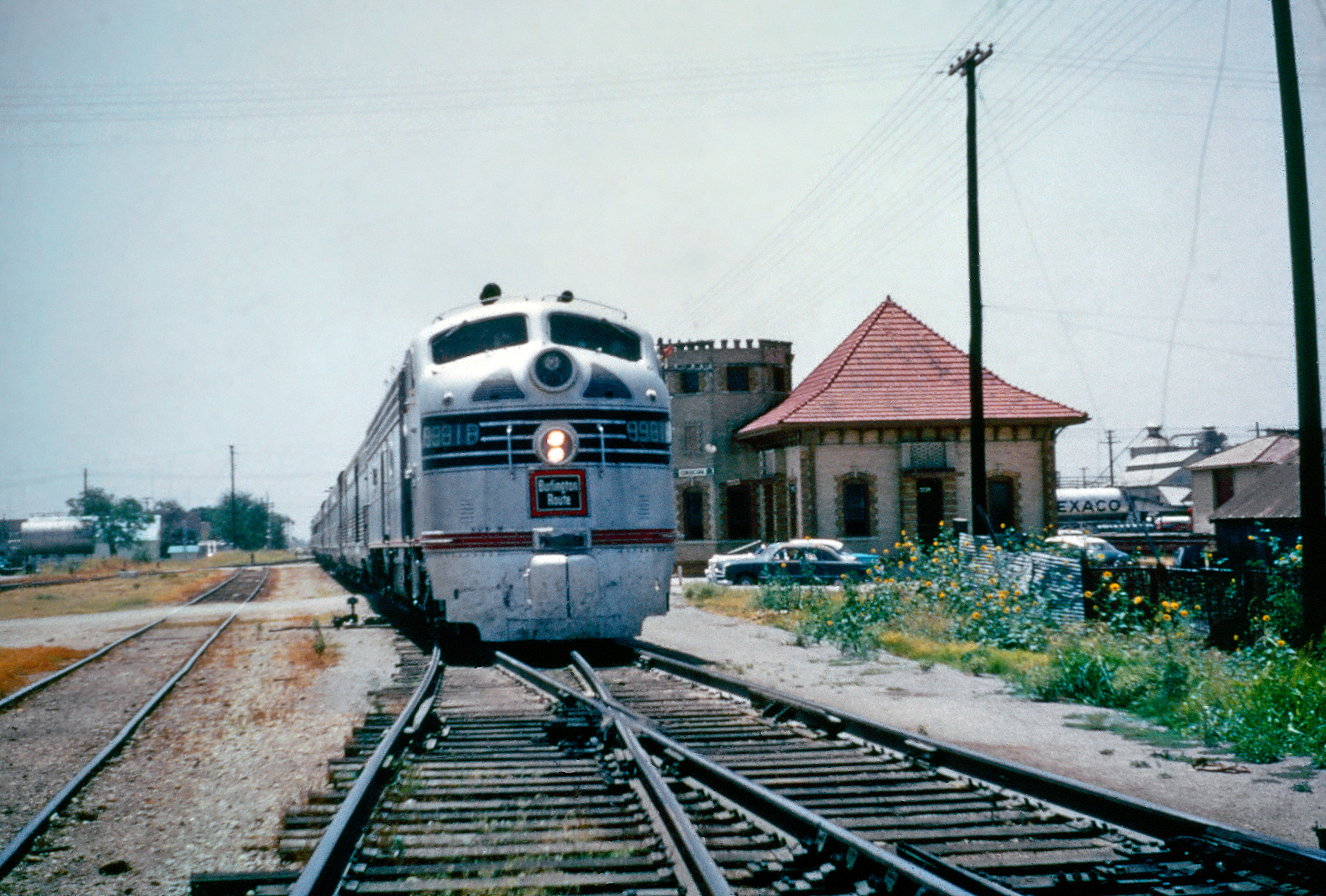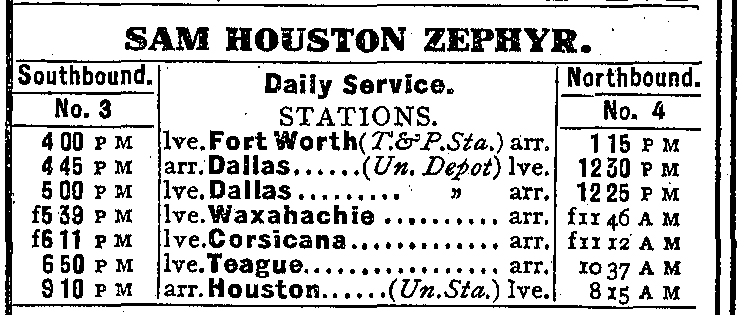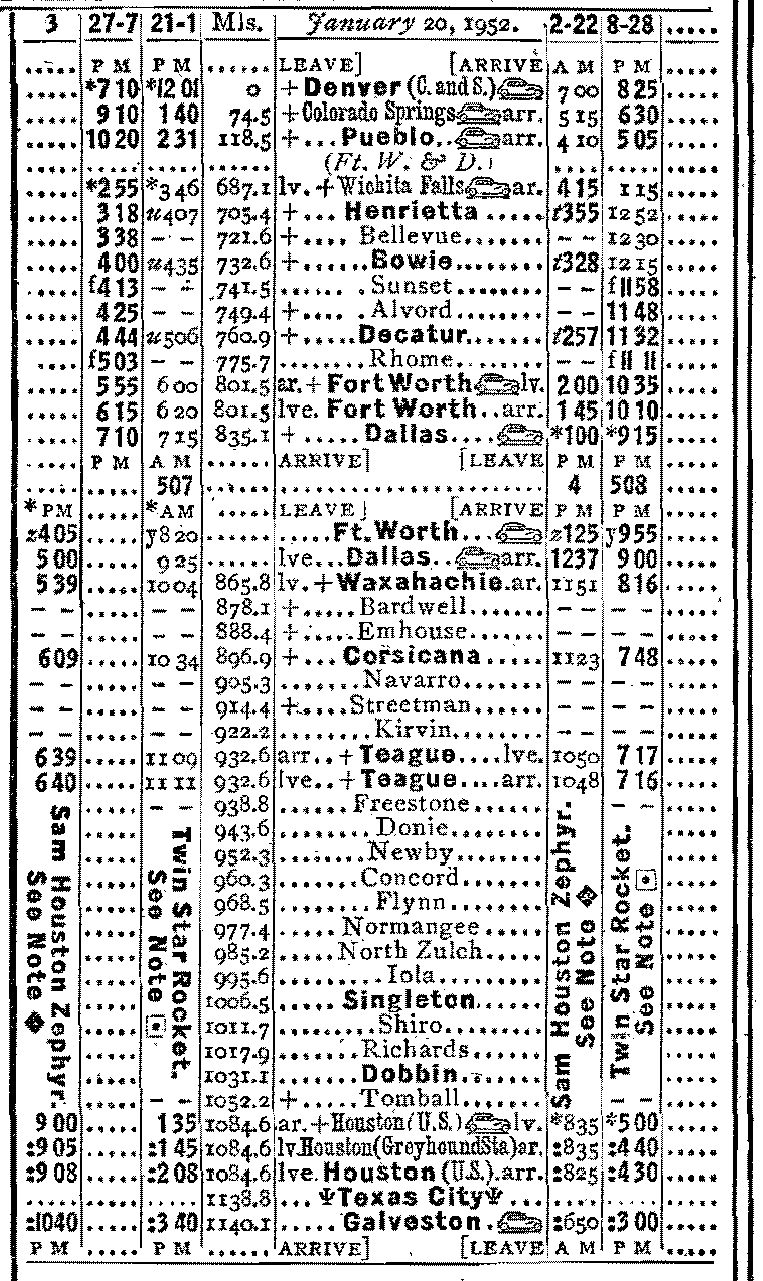"Sam Houston Zephyr": CB&Q's Regional Train
Last revised: September 13, 2024
By: Adam Burns
The Sam Houston Zephyr was a streamlined passenger train operated by the Chicago, Burlington & Quincy over subsidiary Burlington-Rock Island - a system jointly operated by the CB&Q and Rock Island - between Houston and Dallas/Fort Worth in Texas.
It was named after Sam Houston, a key figure in the history of Texas, including as a general at the Battle of San Jacinto, President of the Republic of Texas, and as a senator and governor after Texas joined the Union.
The streamliner was originally launched in 1936 utilizing the former Twin Cities Zephyr trainset, #9901. Its prinicipal competitor was Southern Pacific's (Texas & New Olreans) Sunbeam/Hustler. Service was discontinued along this regional corridor in 1966.
Photos
 Chicago, Burlington & Quincy E8A #9981-B (sub-lettered for the FW&D) is stopped in Corsicana, Texas on the Fort Worth & Denver with train #4, the northbound "Sam Houston Zephyr," during the 1950s. American-Rails.com collection.
Chicago, Burlington & Quincy E8A #9981-B (sub-lettered for the FW&D) is stopped in Corsicana, Texas on the Fort Worth & Denver with train #4, the northbound "Sam Houston Zephyr," during the 1950s. American-Rails.com collection.Inauguaration
On September 11, 1936, a Class I streamlined train named the Sam Houston Zephyr was inaugurated. The train was launched by Burlington Route, responsible for the first diesel-powered streamliner ever put into service; trainset #9900 christened in the spring of 1934.
The success of this train spawned an entire fleet of Zephyrs serving the vast corners of the CB&Q's network. One such train was the Sam Houston Zephyr, which linked Dallas/Fort Worth and Houston.
In fact, this train originally even ran with one of the original Twin Cities Zephyr trainsets, #9901. This original model was iconic and drew substantial attention as it represented the cutting-edge technology of the period. It was designed with aerodynamic features and built with stainless-steel Budd-built articulated equipment.
This vibrant train connected multiple cities in the region, with Houston and Dallas/Fort Worth being its anchor points. From Houston, the train took passengers through Teague, Corsicana, and Waxahachie before arriving at Dallas Union Station. The train completed its trip at the Texas & Pacific Station in Fort Worth.
This routing provided both comfort and efficiency, allowing passengers to experience diverse landscapes in a single journey. The Sam Houston Zephyr, utilized the Burlington-Rock Island Railroad, a joint operation of both systems between Teague and Houston/Galveston.
Carrying the numbers 3 (southbound) and 4 (northbound), the Sam Houston Zephyr continued to utilize the original #9901 trainset until December 19, 1944 when - due to poor maintenance under the Rock Island's care - the power car caught fire and was ultimately scrapped.
The Sam Houston Zephyr was well-known for its high-quality onboard services; the original trainset offered reclining seat coaches and a parlor-lounge-observation while the later train featured a diner-parlor and reclining seat coaches.
Covering a considerable distance of 283.1 miles, the Sam Houston Zephyr held a significant responsibility in connecting Dallas/Fort Worth to Houston.
The journey lasted 5 hours and 5 minutes on southbound runs and 4 hours and 50 minutes on northbound trips (1952), providing a swift and efficient means of transportation for the busy working populace between these two prominent cities.
Timetables
August 29, 1937
January 20, 1952
Final Years
Competition from automobile and air transport coupled with declining patronage led to the final run of the Sam Houston Zephyr on October 1, 1966. It represented the end of an era— one that was symbolic of technological advancement and passenger comfort during the peak of the railroad industry.
Legacy
Despite its cancellation, the Sam Houston Zephyr's legacy continues to live on. The train played a crucial role in connecting and bridging communities, and its contribution to the region cannot be understated. Its memory perseveres particularly among train enthusiasts and historians.
The train was not an isolated endeavor but part of a pioneering movement in streamliners. It belonged to a larger fleet known as the "Zephyr" streamliners, which were operated on the Burlington's considerable network and its subsidiaries.
The "Zephyr" streamliners were the apex of speed, comfort, and luxury during their time. The Sam Houston Zephyr was no different. It was an embodiment of these qualities and served as a symbol for the prosperous eras of the 1940s and '50s.
Despite the decline in the use of railroads for passenger transit, the "Zephyr" fleet's uniqueness still warrants a substantial following. The Sam Houston Zephyr, in particular, is often a focus amongst rail historians, train enthusiasts, and hobbyists.
The Zephyr series showed the world the possibility of speed matched with luxury, a development that indubitably affected other transit modes. The success of this streamlined service generated stiff competition and, ironically, consequently contributed to its own demise.
The Sunbeam, a competing service operated by SP's subsidiary Texas & New Orleans, also ran along the significant Houston to Dallas route. Correlating with the Zephyr's operations, it, too, succumbed to the decline in passenger rail travel and ceased operations in 1955.
Undeniably, the Sam Houston Zephyr holds influential historical value especially in the Burlington and Rock Island's history. It represents an era of innovation, advanced technology, and an unwavering commitment to passenger comfort.
Finally, both the Sunbeam and Sam Houston speak to a time when rail service between both cities was both comfortable and extremely efficient. Interestingly, today, traveling by car between Dallas/Fort Worth-Houston along busy I-45 requires over 4 hours.
The Sam Houston Zephyr's appeal persists in the hearts of railroad enthusiasts. Its story encompasses not only technological advancements but also the human experience—making connections, building communities, and traversing vast landscapes.
While the ride on this regional streamliner might be a thing of the past, its impact and message remain prevalent. It is a testament to the powers of human innovation, an inspiration for technological progression, and a fine model for service in the transport industry.
Consists
August 29, 1937
April, 1952
Understanding the history and significance of trains like the Sam Houston Zephyr provides a glimpse into the promise and potential of rail transit. It serves as a reminder of the golden age of railroads and a testament to the lasting impact of technological advancements on our society.
The train still evokes feelings of nostalgia and admiration for its contribution to the railroad industry. Its legacy serves as a guiding star for future developments in the industry, retaining its relevance even in the face of technological advancements in transportation.
Crafting a narrative of historical significance, beauty, and determination, the Sam Houston Zephyr preserves a place of honor in the annals of American railroad history.
Sources
- Overton, Richard. Burlington Route: A History Of The Burlington Lines. New York: Alfred A Knopf, Inc. 1965.
- Schafer, Mike. Classic American Railroads. Osceola: MBI Publishing, 1996.
- Schafer, Mike and Welsh, Joe. Streamliners, History of a Railroad Icon. St. Paul: MBI Publishing, 2003.
Recent Articles
-
New Mexico Railroad Museums: A Complete Guide
Apr 23, 25 02:25 PM
The enchanting state of New Mexico, known for its vivid landscapes and rich cultural heritage, is home to a number of fascinating railroad museums. -
New Hampshire Railroad Museums: A Complete Guide
Apr 23, 25 02:11 PM
New Hampshire, known for its breathtaking landscapes, historic towns, and vibrant culture, also boasts a rich railroad history that has been meticulously preserved and celebrated across various museum… -
Minnesota Railroad Museums: A Complete Guide
Apr 22, 25 12:17 PM
The state of Minnesota has always played an important role with the railroad industry, from major cities to agriculture. Today, several museums can be found throughout the state.



